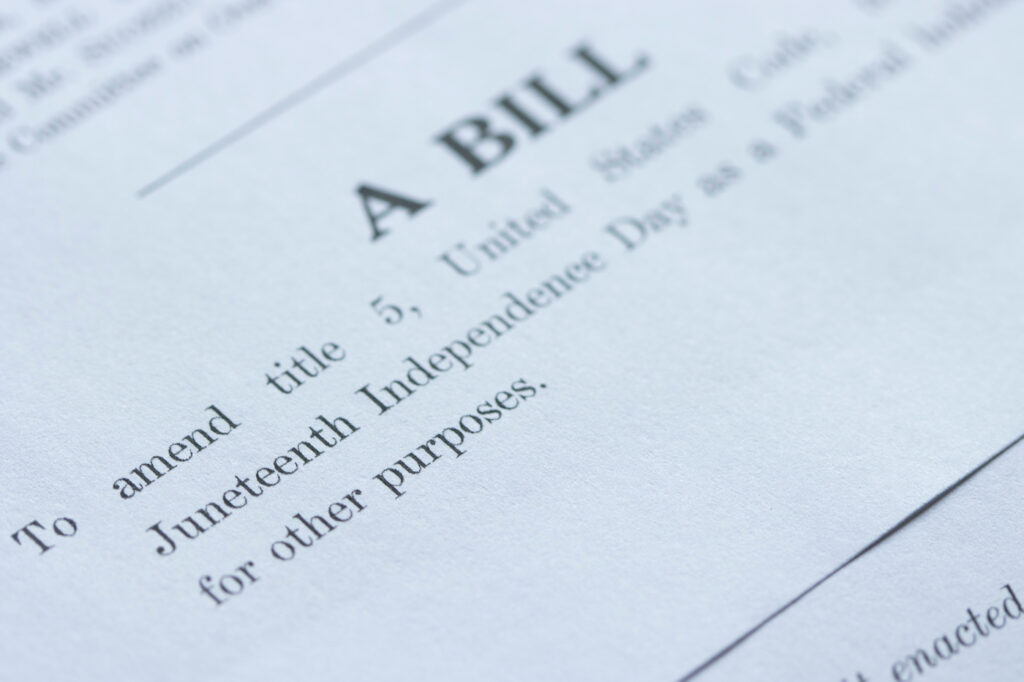Editor’s note: This year is the second time that Americans celebrate Juneteenth as a national holiday. At Public Discourse this week, we offer essays that look back on Juneteenth’s history, and look ahead to consider its place in America’s self-understanding.
Juneteenth is a linguistic compression of the date “June Nineteenth,” with the particular June 19th in view being June 19, 1865. The American Civil War was practically over by that date—the principal Confederate field army under Robert E. Lee had surrendered in Virginia on April 9, 1865, followed by the surrenders of other Confederate forces and the capture of fleeing Confederate president Jefferson Davis on May 10th. But only practically. The United States government had never recognized the Confederacy as a legal entity, and so there were no peace talks or treaty signings to mark a single end-point to the war; the Confederacy simply expired, and did so unevenly, from place to place. In Texas, there were still enough in the way of organized Confederate forces to fight a pitched battle, at Palmito Ranch on May 12th. Palmito Ranch was not a very large or significant battle, but it ended in the withdrawal of Union soldiers back to the southern Texas port of Brownsville, which they had occupied since 1863. Anyone who wanted to declare the war over might find themselves in more danger than they had imagined.
The same thing was true for slavery, which was the principal cause that triggered the war. President Abraham Lincoln had issued an Emancipation Proclamation on January 1, 1863, that declared “forever free” all the slaves in those parts of the breakaway Southern Confederacy not yet returned to Union control. This was an extraordinary step toward the ending of slavery in America, but not the final step. For one thing, Lincoln issued his proclamation on the strength of his “war power” as commander-in-chief, in order to weaken the Confederacy’s powers of resistance. But there was no body of settled law concerning presidential “war powers” in 1863, and even Lincoln was anxious that federal courts might overturn both the proclamation and the freedom it legally awarded to three and a half million black slaves in the Confederacy. For another, the proclamation—precisely because it was a “war powers” document—could only be operative against slavery in the Confederacy; it did not wipe out slavery in the four states where slavery was legal, but which had remained loyal to the Union (Missouri, Maryland, Kentucky, Delaware).
President Abraham Lincoln had issued an Emancipation Proclamation on January 1, 1863, that declared “forever free” all the slaves in those parts of the breakaway Southern Confederacy not yet returned to Union control. This was an extraordinary step toward the ending of slavery in America, but not the final step.
Start your day with Public Discourse
Sign up and get our daily essays sent straight to your inbox.After his reelection to the presidency in November 1864, Lincoln pressed Congress to adopt a thirteenth amendment to the Constitution that would both erase slavery everywhere in the United States and put emancipation beyond the reach of the courts. Congress agreed, by a slim margin, in January 1865. But the amendment would not become legally effective until its ratification by the states, and that would not happen until December 1865. Until then, there was always the chance of a legal or political version of the Palmito Ranch battle that might upset every inch of progress made toward ending slavery.
But the hourglass on these threats was running out swiftly. On May 26th—two weeks after the collision at Palmito Ranch—Confederate General Simon Bolivar Buckner arranged a formal surrender of Confederate forces west of the Mississippi, a surrender confirmed on June 2nd by the last senior Confederate officer in the west, Edmund Kirby Smith. Union commanders were eager to move into Texas as quickly as possible: the Mexican border had been in chaos since the French empire of Napoleon III occupied the former Mexican republic in 1862, and many Confederates were crossing into Mexico to join the French. On June 13th, Union Major General Philip Sheridan, who had been appointed to command the formerly Confederate southwestern states of Louisiana, Arkansas, and Texas, directed Major General Gordon Granger (who had been in command of Union troops occupying the strategic port of Mobile, Alabama) to take charge of all Union forces holding points on the Texas Gulf coast and set up his headquarters at the port of Galveston. Chief among his responsibilities would be to “notify the people of Texas” that, under the terms of the Emancipation Proclamation, slavery had ceased to exist in Texas and that “all slaves are free.”
Gordon Granger was a career U.S. Army officer and a graduate of West Point in the class of 1845 (where he finished a lackluster thirty-fifth in a class of forty-one). He had served in the Mexican War in the Mounted Rifles during Lieutenant General Winfield Scott’s lightning campaign against Mexico City in 1847, and thereafter against the Apache and Comanche in southern Texas. The outbreak of the Civil War brought a demand for anyone with professional experience, and Granger found himself quickly jumped in rank from first lieutenant to command of the 2nd Michigan Cavalry, and then brigadier general of Volunteers, and major general by 1863. One of his superiors characterized Granger as “a man of brains and courage,” but also “blunt to a degree” that would be “well nigh intolerable to strangers.” When an Alabama clergyman asked if Granger intended to require prayers for the president of the United States rather than the Confederacy, Granger sarcastically replied that since the man’s prayers had evidently done little good for Jefferson Davis, “it is no sort of consequence about your prayers, any way.” Still, he served creditably with the Army of the Cumberland at the disastrous battle of Chickamauga, and followed Ulysses Grant in the compensating victory at Chattanooga in 1863, and in 1865 he seemed the perfect choice for coordinating Union occupation of formerly Confederate Texas.
Granger began forwarding troops to Galveston immediately after Sheridan’s order. An advance contingent arrived on June 16th aboard the army transport Corinthian, and Granger arrived in Galveston himself on June 19th, on board the steamer Crescent with “two or three thousand” Union soldiers, and set up headquarters in the Osterman Building. It was at the Osterman Building and other points in Galveston that Granger’s soldiers read and distributed his General Orders No. 3, which (as Sheridan had directed him to do) declared in no uncertain terms that slavery was now over as a fact in Texas, as it had been legally since the Emancipation Proclamation was issued: “The people of Texas are informed that, in accordance with a proclamation from the Executive of the United States, all slaves are free.” Granger even took a small step beyond the ending of slavery, by declaring that the former slaves would now enjoy “an absolute equality of personal rights and rights of property” with their former masters, “and the connection heretofore existing between them becomes that between employer and hired labor.” On the other hand, Granger did not press beyond that to announce an equality of civil rights (that would not occur until the passage and ratification of the fourteenth and fifteenth amendments over the next five years). He assured Galveston’s white inhabitants that “negroes fleeing from the country to this city would not be allowed to live in idleness or become a burthen to the people,” and with his characteristic brusqueness, General Orders No. 3 counseled the freedmen “to remain quietly at their present homes and work for wages” and not “to collect at military posts” in any expectation of being “supported in idleness either there or elsewhere.”
Granger only remained in command in Galveston until August 1st, and spent the remainder of his career until his death in 1876 in otherwise routine Army assignments in the west. But celebrations of June 19th began in Galveston with “a grand turn-out and barbeque” as early as 1866, and in 1872, four black leaders in Houston—John Henry “Jack” Yates, Richard Allen, Richard Brock, and David Elias Dibble—purchased a ten-acre “Emancipation Park” that became the focus for “Juneteenth” observations. By 1902, there were “five or six barbeques given by the colored people” in Brazos County alone, despite the sniffing disapproval of disgruntled white Texans that “our carnival-like Juneteenth outings” and “burlesque parade” should be “knocked on the head and done with”—and despite the offer by the “colored people” in 1909 to “prepare a special table for their white friends … so they may have the pleasure of entertaining them.” Juneteenth became “a second Christmas” for black Texans, with “everything especially set aside for that day.”
Celebrations of June 19th began in Galveston with “a grand turn-out and barbeque” as early as 1866, and in 1872, four black leaders in Houston—John Henry “Jack” Yates, Richard Allen, Richard Brock, and David Elias Dibble—purchased a ten-acre “Emancipation Park” that became the focus for “Juneteenth” observations
At first, Juneteenth was only a Texas holiday (and not even a formal state holiday until 1979, even though cities like Austin made it a municipal holiday as early as 1946) and had to compete with fifteen other emancipation holidays observed elsewhere by black Americans. The earliest of these holidays, even before the Civil War, was August 1st, in recognition of the abolition of slavery in the British West Indies in 1834; yet another, in the District of Columbia, was (and is still) held on April 16th, to mark the signing of the District of Columbia emancipation bill by President Lincoln in 1862. Other holidays included the official ending of the transatlantic slave trade in 1808, and the ratification date of the thirteenth amendment. The most prevalent, for decades, was January 1st—“Emancipation Day”—in remembrance of Lincoln’s signing of the Emancipation Proclamation, which featured “Watch Night” church services beginning on New Year’s Eve and lasting into January 1st.
Gradually, however, Juneteenth has superseded even January 1st in importance as a black emancipation holiday. “The way it was explained to me,” recalled one black Texan, “the 19th of June wasn’t the exact day the Negro was freed,” but “that’s the day they told them that they was free,” and they “whooped and hollered and bored holes in trees with augers and stopped it up with [gun] powder and light that, and that would be their blast for the celebration.” By the 1920s, there were Juneteenth celebrations in Shreveport, Oklahoma City, Los Angeles, and Phoenix, with “a parade through the principal downtown streets … and floats showing the gradual progress of the Negro from 1865 to 1920.” Annette Gordon-Reed, a native Texan and legal historian, recalled that, “for my great-grandmother, my grandparents, and relatives in their generation, this was the celebration of the freedom of people they had actually known.”
After World War II, black migration from the rural South to northern cities carried Juneteenth celebrations with it, and black historian Peniel Joseph recalled how “Each year we would commemorate the day, often during a Sunday service and occasionally during vacation Bible school. … I imagined myself as part of the Black Texas community, which dared to believe in dreams of freedom that were once considered impossible.” Ralph Ellison’s unfinished novel, Juneteenth, captures the fiery spirit of Juneteenth celebrations when its principal character, Reverend Hickman, describes slavery as a kind of preparation for “the awe-inspiring labor of transforming God’s Word into a lantern,” a preparation that has continued because “He wants a well-tested people to work his will,” even “a new kind of human.” Opal Lee, a retired school teacher from Ft. Worth, began staging symbolic “walks” from Ft. Worth to Washington, D.C., to advocate the designation of Juneteenth as a national holiday, and in 2021, she was rewarded by the passage of a bill creating a national Juneteenth holiday.
Juneteenth has had its ups and downs as “a red-spot day on the calendar.” The foremost chronicler of black holidays, William H. Wiggins, believed that in the 1960s, interest in Juneteenth waned to the point of evaporation, only to be re-invigorated in the 1970s. The principal irony of Juneteenth, however, is that slavery was still a legal institution in the United States on June 19, 1865—if not in Texas because of the Emancipation Proclamation, then certainly in Kentucky and Delaware, where slavery would not be blotted out until the ratification of the thirteenth amendment. This would not, however, be the only irony in the history of American emancipation, and certainly not the last.














